
FDA Approves Estradiol Gel, 0.06% for Women Post-Menopause
Key Takeaways
- Estradiol gel, 0.06%, is approved for postmenopausal symptoms, including hot flashes and vaginal changes, and can prevent osteoporosis.
- The gel reduces hot flash frequency by 75% and symptom severity by 50-55%, with significant improvement within 2-4 weeks.
In postmenopausal women, the gel can reduce moderate to severe hot flashes as well as menopausal changes and symptoms.
The FDA approved estradiol gel, 0.06% (ANI Therapeutics) for use after menopause to reduce moderate to severe hot flashes and moderate to severe menopausal changes in and around the vagina. Additionally, the gel can treat symptoms caused by the removal of the ovaries, as well as prostate and breast cancer and prevent osteoporosis. This approval is for the generic version of the reference listed drug—EstroGel Gel, 0.06% (Ascend Therapeutics)—which was originally approved in February 2004 to treat moderate to severe symptoms of vaginal and vulvar atrophy.1,2
According to the FDA, estradiol gel is used topically and can be administered daily. It is recommended that 1 pump (1.25 g, which contains 0.75 mg of estradiol) per day is applied to the arm. Additionally, if estrogen is prescribed for a woman with a uterus who is postmenopausal, a progestin should be considered to reduce the risk of endometrial cancer, but a woman without a uterus does not need progestin. In some cases, women who have received a hysterectomy and with a history of endometriosis may need a progestin. Further, in the case that estradiol gel is prescribed solely for the treatment for moderate to severe symptoms of vulvar and vaginal atrophy, topical vaginal products should also be considered.3
There was no measurable transfer of estradiol 1 hour following application, as demonstrated in a clinical study evaluating 24 non-dosed healthy postmenopausal women after direct skin-to-skin contact with subjects who were administered estradiol gel.4
Endogenous estrogens are primarily responsible for the development and maintenance of the female reproductive system as well as secondary sexual characteristics. Although circulating estrogens exist in a dynamic equilibrium of metabolic interconversions, estradiol is a principal intracellular human estrogen that is considered more potent than the metabolites—estrone and estriol—at the receptor level. In addition, the primary source of estrogen in normally cycling adult women is the ovarian follicle, which secretes 70 to 500 mcg of estradiol daily; however, this depends on the phase of the menstrual cycle.2
Study findings published in Sexuality, Reproduction, and Menopause demonstrate that 890 menopausal women who were prescribed estradiol gel and completed at least 1 follow-up Menopause Symptom Questionnaire, hot flash frequency was reduced by approximately 75%, with the number of hot flashes per day lowering from 5.87 to 1.44. Additionally, hot flash and vaginal dryness severity were reduced by about 55% and 50%, respectively. Of these respondents, approximately 75% of reported improvement by 2 weeks, 89% by 3 weeks, and 95% by 4 weeks.5
The most common adverse events (AEs), according to the FDA, include headache, flatulence, and breast pain or tenderness. Other AEs can include stomach or abdominal cramps, bloating, nausea and vomiting, hair loss, fluid retention, and vaginal yeast infection. In some cases, serious AEs may include cardiovascular disorders (eg, stroke, coronary heart disease, venous thromboembolism) and malignant neoplasms (eg, endometrial cancer, breast cancer, ovarian cancer). In 2 controlled clinical trials, application site reactions were reported by approximately 0.6% of patients who received 1.25 g of estradiol gel, with other skin reactions (eg, pruritus and rash) also reported by patients.2,3
Additionally, the experts noted that based on the August 2024 moving annual total IQVIA data, US annual sales for estradiol gel were approximately $16.7 million. Having a generic option can serve as a more accessible or affordable option for patients.1
"With the FDA approval and commercialization of estradiol gel, 0.06%, we are pleased to bring another limited-competition product to market and ensure that customers and patients in need have ready access,” said Nikhil Lalwani, president and CEO of ANI Pharmaceuticals, in a news release.1
REFERENCES
1. GlobalNewswire. ANI Pharmaceuticals Announces the FDA Approval and Launch of Estradiol Gel, 0.06%. News release. October 25, 2024. Accessed October 25, 2024. https://www.globenewswire.com/en/news-release/2024/10/25/2969362/0/en/ANI-Pharmaceuticals-Announces-the-FDA-Approval-and-Launch-of-Estradiol-Gel-0-06.html
2. 3476985 this label may not be the latest approved by FDA ... Accessed October 25, 2024. https://www.accessdata.fda.gov/drugsatfda_docs/label/2014/021166s010lbl.pdf
3. EstroGel. Why Choose EstroGel? — Indication & Important Risk Information. Accessed October 25, 2024. https://www.estrogel.com/what-is-estrogel/
4. EstroGel. For Healthcare Providers. Accessed October 25, 2024. https://www.estrogel.com/for-healthcare-providers/
5. Simon JA, Mackowiak JI. Independent web-based vs “meaningful use” patient portals in assessing patient-reported outcomes: the estradiol gel 0.06% case study. Sex Reprod Menopause. October 2011;(suppl):1-9.
Newsletter
Stay informed on drug updates, treatment guidelines, and pharmacy practice trends—subscribe to Pharmacy Times for weekly clinical insights.








































































































































































































